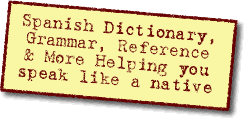Ask a Question(Create a thread) |
|
|||||||
Indirect object vs. direct object issueThis is the place for questions about conjugations, verb tenses, adverbs, adjectives, word order, syntax and other grammar questions for English or Spanish. |
 |
|
|
Thread Tools | Display Modes |
|
#1
|
|||
|
|||
|
Indirect object vs. direct object issue
Hi,
I'm running into a bit of a snag on the verb "to push" in terms of identifying the appropriate object form. Normally verbs which suggest the transfer of something qualitatively differentiable between subject and object permit the substitution of the indirect object with the indirect object pronoun. If the contact or interaction is simple and qualitatively non-differentiable then (AIUI) the indirect object doesn't exist and no such substitution is possible. Example El padre mira a sus hijos --> Mirar, to look, is simple and does not permit the transfer of anything qualitatively differentiable. Thus we can eliminate the IO as a possibility and select the DO --> El padre los mira. El padre habla a sus hijos --> Hablar is not simple and can permit the transfer of qualitatively differentiable things, i.e. words/thoughts, from (subject) father to (object) son. We could add a clause which ties directly to the main clause such as: El padre habla a sus hijos sobre la tarea. We conclude this is an IO and write: -->El padre les habla. What about empujar? "Carlos empuja a Juan" -->A push could allow something to be transferred such as when an object is "pushed onto" someone else. Though this is normally meant figuratively (at least in English) it could be literal as well. You could push a stick onto/into someone's chest, for example, not a pleasant thought but certainly possible. Now in the case of speech (hablar) we are saying that, although we aren't specifying what is being spoken (in the above case), it could be specified, and that possibility is what permits the classification as an IO. Couldn't the same be true of empujar? Yes a thing could be pushed onto them, we just aren't specifying it at the moment. Now I see from examples that the object pronoun for empujar is always (at least I've seen no exceptions yet) the DO. I'm trying to nail down the object pronoun business a little more (from seat-of-pants to rigorous) so any thoughts would be appreciated. Thanks 
|
|
Get rid of these ads by registering for a free Tomísimo account.
|
|
#2
|
||||
|
||||
|
AFAIK:
If you're pushing the stick into someone's chest, the DO is the stick, and the IO is the person. But if you're pushing the person onto the stick, the person is the DO and the stick is the IO. |
|
#3
|
||||
|
||||
|
Le estás dando (a él, al individuo) con el palo en el pecho.
Estás empujándola (a ella, a la persona) contra la estaca. En cualquier caso, esas parecen acciones deleznables, que no deberías hacer.
__________________
Lo propio de la verdad es que se basta a sí misma, aquel que la posee no intenta convencer a nadie. "An enemy is somebody who flatters you. A friend is somebody who criticizes the living daylights out of you." |
 |
| Tags |
| direct, indirect, object |
«
Previous Thread
|
Next Thread
»
| Link to this thread | |
|
|
|||||||
 Similar Threads
Similar Threads
|
||||
| Thread | Thread Starter | Forum | Replies | Last Post |
| Direct / indirect object | daboiarusselli | Grammar | 6 | October 04, 2009 12:42 PM |
| Using Indirect and Direct Object Pronouns Together | Elizabeth | Grammar | 3 | August 13, 2009 11:09 AM |
| direct and indirect object pronouns | gramatica | Vocabulary | 2 | January 16, 2008 06:27 PM |
| direct object pronouns and indirect object pronouns | Twitchy11 | Grammar | 3 | September 29, 2007 12:37 PM |
All times are GMT -6. The time now is 04:39 AM.








 Linear Mode
Linear Mode

